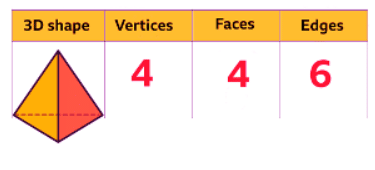Sort 2D and 3D shapes | Year 3 Mathematics PDF Download
| Table of contents |

|
| Sorting Shapes |

|
| 2D Shapes |

|
| Sorting Shapes by Vertices |

|
| 3D Shapes |

|
Sorting Shapes
- To effectively categorize 2D and 3D shapes, we rely on distinct characteristics such as the number of sides or faces.
2D Shapes
- JJ is arranging shapes in order of sides, starting from the fewest to the most.

- Counting the number of sides is fundamental. Ensure each side is only counted once.
- When counting sides, avoid counting the same side multiple times.

- Understanding the sides of each shape enables us to arrange them from the least sides to the most sides.

Importance of Investigation
- Investigation plays a pivotal role in mathematics as it helps us identify various patterns and rules. For example:
- Observing that two shapes may have the same number of sides but appear different.
Sorting Shapes by Vertices
- Another method of classification is based on the number of corners, known as vertices, a shape possesses.

- Let's examine the shapes again, this time focusing on counting the vertices.

- Do you notice any patterns? In 2D shapes, the number of vertices is equal to the number of sides.

3D Shapes
Exploring the properties of 3D shapes can reveal interesting characteristics.
Let's assist JJ in determining the vertices, faces, and edges of a specific 3D shape. Let's count the vertices and faces together, organizing our findings in a table.
Let's count the vertices and faces together, organizing our findings in a table. Investigation involves testing ideas. JJ theorizes that 3D shapes have the same number of edges as vertices, akin to our earlier observation with 2D shapes.
Investigation involves testing ideas. JJ theorizes that 3D shapes have the same number of edges as vertices, akin to our earlier observation with 2D shapes.
Lets verify this theory by counting the edges. This particular shape has 6 edges.
This particular shape has 6 edges.
JJ's hypothesis was proven wrong.
It's essential to embrace incorrect ideas as part of the investigative process in mathematics.
Example
Example: Did you notice that this shape has the same amount of vertices as faces?
Does that mean all 3D shapes have the same amount of vertices and faces?
Let's test that theory - count the faces, vertices and edges of these 3D shapes. Let's see if the theory is correct.
Let's see if the theory is correct.
Not all 3D shapes have the same number of vertices and faces so the theory was incorrect.
Don’t be afraid to make mistakes – mistakes help you learn.
This is what investigating is all about!
|
69 videos|67 docs|11 tests
|

|
Explore Courses for Year 3 exam
|

|






















